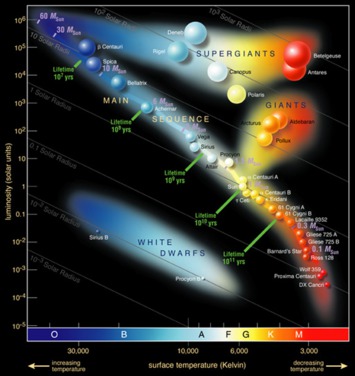Most stars appear white, but look closely and you'll notice that some do have a color, often a slight blue or orange hue. Star colors are not very saturated, and since the human eye is not particularly sensitive to colors in low-light conditions, the colors are subtle. A reflecting telescope can enhance the colors, but we wary of inexpensive models that can refract light in such a way that the stars exhibit false colors.
Red stars—like Antares, Aldebaran, and Betelgeuse—are cool. Blue stars—like Deneb, Rigel, and Spica—are hot. Bright red stars (which actually look orange or even yellow) are red giants or supergiants—hugely swollen stars with bloated atmospheres. They can be so large that, were one placed at the center of our solar system, Mars would orbit beneath its surface!
Blue stars shine brightly not because of their size, but because of their intense heat. Their high surface temperature of 25,000 degrees Celsius (45,000 degrees Fahrenheit)—compared to a mere 3,500 degrees Celsius (6,300 degrees Fahrenheit) for a red giant—gives them a luminosity 10,000 times or greater than that of the sun.
Other red stars, called red dwarfs, are the most common type of star, but are so intrinsically faint that none, even those closest to Earth, can be seen without a telescope.
